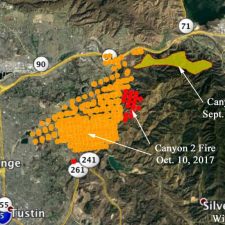(Above: The red dots represent heat detected on the Canyon 2 Fire by a satellite at 2:54 a.m. October 10. The yellow dots were detected at 12:54 p.m. October 9. The Canyon Fire started September 25, and the spread was stopped a few days later. Click to enlarge)
A couple days ago, Fire Aviation readers made a reasonable ask to news media filming water and retardant drops: Pan the camera out.
You’ve been heard.
A television crew with KTLA in Southern California got a great vantage of Tanker 911, a DC-10 operated by 10 Tanker Air Carrier, making a run over the hills east of Anaheim during efforts to contain the Canyon 2 Fire.
Check it out:
#CanyonFire2 latest:
-7,500 acres burned
-25% contained
-14 structures destroyed
-22 structures damaged
More: https://t.co/m9anuSwKDW pic.twitter.com/rUDsl5r2fV— KTLA (@KTLA) October 10, 2017
The Canyon 2 Fire started Monday morning in the Anaheim Hills area.
By Tuesday, Anaheim Fire & Rescue reported the blaze to be at 7,500 acres. About 1,100 firefighters were assigned to the incident, with 14 helicopters and six planes assisting from the air.
A water dropping helicopter flies over Anaheim as smoke from the #Canyon2Fire covers Orange County #canyonfire @ocregister @AnaheimFire pic.twitter.com/suzltYQduD
— Jeff Gritchen (@jeffgritchen) October 10, 2017
As of Wednesday morning, it had grown to 8,000 acres with containment at 40 percent — a shift from Santa Ana winds from the east to coastal sea breezes from the west aided containment efforts.
Roughly two-dozen structures were damaged or destroyed, but no serious injuries were reported.
A solid containment line has been created along the eastern edge of communities near the 241 Toll Road. #CanyonFire2
— Anaheim Fire &Rescue (@AnaheimFire) October 11, 2017


I believe I read that they changed the discharge system from the Evergreen configuration. I don’t know if the Evergreen system atomized the water/suppressant/retardant like the GST does. I have seen a couple of videos of the GST drop taken from the ground in the drop zone and it is very apparent that the liquid comes down in nice droplets like a rain shower vs. like a dump from a WalMart swimming pool.
What I haven’t been able to find is what you mention, reliable information on how effective it is on real fires, either at helping to control and knock down the fire or create effective retardant lines that actually hold the fire.
Grid test: Same discharge system as used in the Evergreen 747, IATB approved? Chile the 747 used a fire suppressant. Compared to a long term retardant the results may be different. When it comes to fire line effectiveness I’m probably the most critical person in fire aviation. (now retired). If the 747 wasn’t doing the job and fitting into the overall air attack plan especially with the multiple close proximity fires (super smoky) then I would expect Cal Fire to terminate its (T 744) use. From the few video clips I have been able to observe it appears that the system is working as designed, with one exception, the retardant coverage level may be a little too high. Need fire field reports to be the judge of effectiveness. Is it working for the folks on the ground? (forget the grid crap)
I have done a lot of “googling” on the Global Supertanker and I cannot find any scientific analysis or even anecdotal information on the 747’s effectiveness on fires in general, or more interestingly, compared to the other VLATs or SEATs.
Anyone have any info on this? Anyone? Bueller?
Good question. Perhaps the AFUE program has enough data by now to support a definitive study? They have been collecting data since 2012.
https://fireaviation.com/2017/01/19/air-tanker-study-has-collected-data-on-7000-drops/
Without some genuine hard data and ops analysis, its all anecdotal evidence and opinions when it comes to air tanker effectiveness and utility in the U.S.
That is how its done, the total event. Air tanker, drop and results. Rumors are that two P2V’s are out of recent retirement and headed to California from New Mexico. Increasing winds in Northern California starting after sunset today, Wed the 11th.
Yesterday here in norcal,im in Auburn,we had a fire close to my home,was small, i think it was 20 acres,but T89 spotted the smoke before it was even dispatched and diverted to this new fire,he and either T95 or T88,i believe it was T95, took action on it before engines arrived and corralled it quickly.if they had waited it may have gone to 100+ quickly,i think on another p[ost i may have said it was 100 acres,but it wasnt..lol..anyway,they did a great knock down saving several homes,even the home of Brad Sweets grandfather,this grandfather is also the grandfather of Kyle Larsons wife.both men Brad and Kyle race in nascar and sprint cars,,Larson drives the #42 in the cup division.
yes johnny 2 P2Vs are on station. Tankers 05 and 14, they really aren’t out of retirement because per the contract the government can recall them to service up to 30 days after their MAP period.